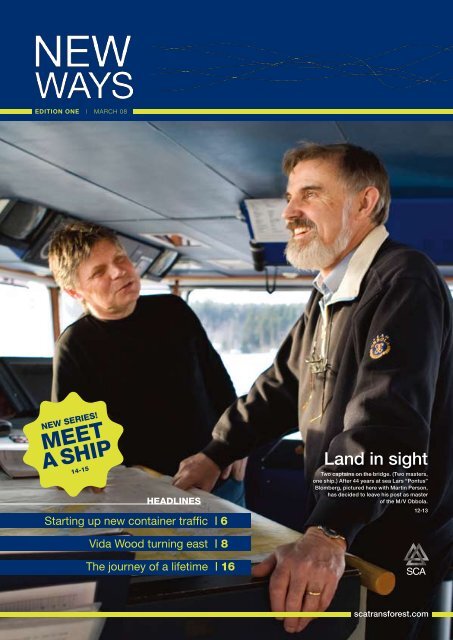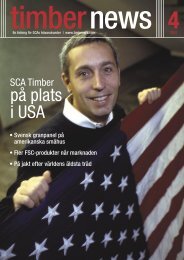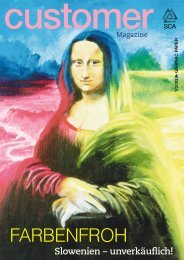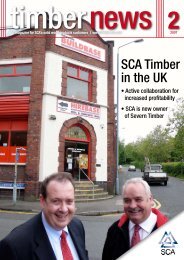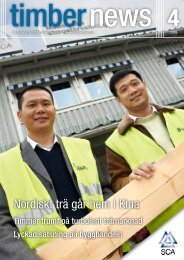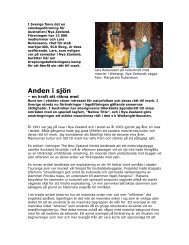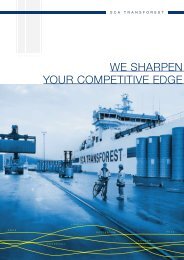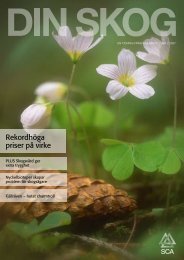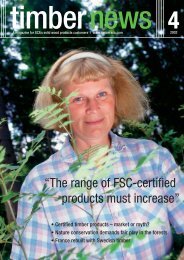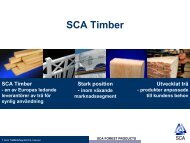MEET ASHIp - SCA Forest Products AB
MEET ASHIp - SCA Forest Products AB
MEET ASHIp - SCA Forest Products AB
You also want an ePaper? Increase the reach of your titles
YUMPU automatically turns print PDFs into web optimized ePapers that Google loves.
EDITION ONE | march 08New series!<strong>MEET</strong>a ship14-15HEADLINESStarting up new container traffic | 6Land in sightTwo captains on the bridge. (Two masters,one ship.) After 44 years at sea Lars “Pontus”Blomberg, pictured here with Martin Person,has decided to leave his post as masterof the M/V Obbola.12-13Vida Wood turning east | 8The journey of a lifetime | 16scatransforest.com
Tunadal Sawmill invests for greater volumeswhich will have a positive effect also for nearbyInterforest Terminal Sundsvall and the port.Modernising Tunadal sawmill<strong>SCA</strong> is investing SEK 210 million (EUR 22.4m) in a new automatic grading mill that will replacethe Tunadal sawmill’s two existing grading mills. The investment in modern technology results inincreased production and higher product quality, but 28 positions will be eliminated when the newplant is started up in autumn 2009.“This is an important and long-awaitedinvestment for us at Tunadal,” sayssawmill manager Jerry Larsson. “It isa necessary step in our work to developTunadal into a spruce sawmill thatcan compete with the best in Europe.And that is where we have to be.”The new grading system is preparedfor a future planing mill.The investment will result in reducedproduction costs, higher quality outcomeand less waste.Increased productionMoreover, production will increase fromthe current level of 332,000 cubic metresof solid-wood spruce products to 347,000cubic metres. The new grading mill willhave the capacity to handle production of750,000 cubic metres of sawn products.“We have increased production andproductivity at the Tunadal sawmillthrough a number of investments,”says Jerry Larsson. “We’re now takinganother major and importantstep forward.”3 NEW WAYS
Investmentopens windows<strong>SCA</strong> is investing SEK 93 million(EUR 10.1m) in a plant to producewindow components at its Munksundsawmill outside Piteå, Sweden.The two shifts at the new plant,24 people, will produce over 30,000cubic meters, five million runningmetres, of window components.Plant start is scheduled forOctober 2008.“A significant portion ofMunksund sawmill’s productionis already used for windowproduction,” says Anders Nordmark,manager of Munksund sawmill.“We have the right raw materialand equipment to produce themefficiently. The demand for highqualitywood window frames isincreasing and this investmentstrengthens our position as asupplier to this important market.”<strong>SCA</strong> Timber’s ambition is toincrease value-added processing andgrow as a supplier of components tothe wood-processing industry.X-ray scanningat Bollsta sawmillDid you know ?- For 12 years <strong>SCA</strong> Transforest system vessels have being makingscheduled calls at ports such as Umeå, Husum, Sundsvall,Iggesund, London and Rotterdam.- During 2008 <strong>SCA</strong> Transforest will handle close to 200,000containers (TEUS) at sea and its terminals.<strong>SCA</strong>’s Bollsta sawmill is investingSEK 49 million (EUR 5.2m) inequipment for x-ray scanning ofsawlogs for timber grading.X-ray scanning of raw materialsallows the selection of wood with theexact properties required for a certainproduct. Consequently, the sawmillwill be able to maintain higher andmore uniform product quality.The investment will also mean betterraw material utilisation as well asreducing waste and sorting out ofproducts that do not meet customerspecifications. Better raw materialuse also means that the sawmill’sproduction capacity can be increased.In addition to the x-ray equipment,this investment also includes a newsawlog table and measurementequipment. Procurement will be carriedout this spring and the new equipment isexpected to be in operation in 2009.5 NEW WAYS
The 132 metre long Merwedijk is ice-class1A and has a service speed of 17.5 knots.New containertraffic to HamburgAs of 5 March 2008 <strong>SCA</strong> Transforest and container carrier UniFeeder operates weekly containertraffic from Umeå and Sundsvall to Hamburg.Photo Linda Snell<strong>SCA</strong> Transforest currently operatesregular container traffic from Umeåand Sundsvall to Rotterdam fromwhere the containers are forwardedto destinations around the world.This service has been running since1998 and has grown considerably insize in recent years. The containerisedcargo destined for Rotterdam has beencombined with other goods.“Container traffic has grown somuch in volume that we can now launcha container-only service together withUniFeeder, a company specialising inthis sector,” says Magnus Svensson,president of <strong>SCA</strong> Transforest.»UniFeeder A/Swas established in1977 and today hasEurope’s largest seatransport networkfor containerisedcargo.«NEW WAYS 6
Leaders in pallet collarsand cable drumsIn recent years, parallel with the growthof the sawmill operations, Vida has alsoinvested heavily in one of its subsidiaries,Vida Packaging, which is Sweden’slargest manufacturer of pallet collarsand cable drums. Vida Packaging’sannual production totals two millionpallets, 2.7 million pallet collars and200,000 cable drums. Volvo is oneof the company’s biggest customers.Another business area is Vida Energi,which annual produces 75,000 tonnesof wood pellets that are sold to heatingplants in Sweden.Pulp and fine paper millSince 1 September 2006, when theLessebo mill was acquired frombankrupt Klippan <strong>AB</strong>, Vida is alsoengaged in the making of fine paper.Each year Vida Paper, as the businessis now known, produces 33,000 tonnesof pulp and 60,000 tonnes of high-qualitycoloured fine paper for theprinting industry.“This has been, and remains, aprocess of learning a new line of businessand making production profitable.We’ve recruited new management andthe mill operation is increasingly better.We see a bright future for Vida Paper,”says Agust Thordarson.Looking to India and RussiaMore than 85 percent of the sawmills’production is exported. While Swedenis an important market so are theUK, Germany, Denmark, the Beneluxcountries and the Far East, particularlyJapan and Korea. The USA, once amajor market for Vida, has declinedin significance in the past year due tothe weakening of the dollar.Great emphasis is now placed ondeveloping new markets, especiallyeastern Europe and India.“We’ve just started exporting to Indiawhere the country’s middle class is growingstrongly and their buying power is on therise. As early as next year we see Indiabecoming a very interesting market forus. More and more building is underwayand the demand for timber is climbing.We can also see a similar development inRussia where people are now consumingthe country’s own products to a greaterextent, products that used to be exportedto elsewhere in Europe.”Own VMIsIn recent years Vida Wood hasincreasingly taken control over thelogistic flows involved in the sale ofsawn wood products. The sawmillshave moved closer to the markets, so tospeak, and taken command over logistics.“We’ve established our ownwarehouses and vendor managedinventories (VMIs) in our mostimportant markets in order to movecloser to our customers and be able todeliver more quickly. We are also aimingto manage the customers’ own stocks attheir facilities,” says Agust Thordarson.While shipments to northern Europeare carried by road and rail all deliveriesto the UK, Ireland and the USA arecarried by ship. Upon arrival Vidalooks after the domestic transport to thecustomers. They primarily use Halmstadand Varberg, and Gothenburg to someextent, as shipping ports.“For the UK we have lines thatdepart weekly and service ten differentports. We’re unique when it comes toshipping to the USA. We charter ourown vessels that exclusively carry Vidaproducts to the ports at Wilmington,North Carolina and Port Canaveral,Florida,” says Agust Thordarson.Own train companyDeliveries in Sweden are primarilycarried from the sawmills by road orrail. Here Vida has been operating itsown train company for the past fouryears. Nordic Train, as the company isknown, serves four sawmills with directtransport to the ports at Halmstad andVarberg. So far, the single locomotiveand the 150 wagons have succeeded incapturing and carrying 20 percent ofthe total sawmill production.“We’re trying to utilise the wagonsas much as we can. We’re also lookingat the possibility of running “chip trains”for pulp production as well as increasingthe carriage of timber and pulpwood,”says Agust Thordarson, who sees manyadvantages in owning a railway company:“This solution provides greatenvironmental benefits, it’s cheaper, moreAgust ThordarsonTransport & logistics manager, Vida Woodflexible and cost-efficient since we canload the wagons directly at the mills.”However, he also points out thatNordic Train differs from otherrailway companies.“We make use of old wagons andtry to keep the organisation very lean.”At the same time, Nordic Train hascertain limitations.“We only have working track to fourof our sawmills and the competitionfor time on the Swedish rail network isincreasing. This can make transportsmore difficult in some regions.”Cost awarenessAgust Thordardsonn is counting on theproportion of intermodal transports alsoincreasing for Vida.“It goes without saying that it’smore efficient and cheaper if we can carry20 containers on a train to Gothenburgthan if we have to send them by truck.This isn’t possible in practise right now butit’s something we’re going to look closerat in the future,” he says before adding:“Our cost awareness is high at Vidaand thankfully it also fits nicely withour progressive environmental approach.As long as we think in terms of costefficiency we’re also promoting moreenvironmentally sound solutions.”9 NEW WAYS
F<strong>AB</strong>ULOUS FACTSID:Owner:Home port:Built:Important figures:Length over all 107.45 mBreadth moulded 17.00 mDraught summer 6.07 mDWT summer on6.07 m draught 4,453GT LondonRules 1969 5,627NT LondonRules 1969 1,877M/S LinkGodby ShippingFinström1989 by JJ Sietas Schiffswerft in GermanyCargo handling equipment:Stern ramp 12.0 x 9.25 m (L x B)Side loader with 2 lift platforms, 3.20 x 1.60 m eachLifting capacity 12 t per platform2 air drying aggregates for lower hold and main deckContainer capacity and reefer plugs:180 TEU or 90 FEU on deckStack load on deck 40/50 t per 20’/40’ stack20 reefer plugs on main deck and weather deckGLOSSARYTEU = Twenty-foot Equivalent UnitFEU = Forty-foot Equivalent UnitDWT = Dead Weight Tonne15 NEW WAYS
The journey of a lifetimeOn 1 June 1965 <strong>SCA</strong> employed a 22-year old “youth” as a charterer in its Distribution Department,which at that the time was part of the Sales Department. Sales also covered the DocumentDepartment and production planning for paper and the staff included both travelling and in-housesales representatives.Photo Linda SnellEverything was located along the same corridor and the distancefrom decision to action was short in every respect. The youth’sexperience of shipping and ships was limited to having seen thetugboat Ljungan moving logs along the river of the same nameplus that he passed the vessel’s berth on his frequent visits to thelocal football pitch. Chartering was, well, uncharted water.Three charterers under the supervision of a manager staffedthe department. One charterer was responsible for the UKand West Germany, the second for overseas shipments, largelydestined for South America where, at the time, <strong>SCA</strong> exportedsubstantial volumes of newsprint, foremost to Buenos Aires.The youth’s job was to handle shipments to the Be-Ne-Luxcountries, France, Spain and Italy. Some shipping companiesemployed then included Rederiaktiebolaget Svea, Transmarin,Irisbolagen, Thunrederierna, Svenska Loyds and Johnson Linjen.Shipping structure in the ´60sThere were no less than seven shipping locations in the Sundsvallarea at the time. There were five pulp mills (including Kramfors),printing papers from Ortviken and Matfors plus kraft paper fromWivstavarv, with the start coming in 1966 when <strong>SCA</strong> acquiredthe company. A kraftliner mill today, Obbola was a pulp millproducing products known as Buffafo and Obbola E until 1973.Solid wood products had their own distribution system.The shipping contracts for the European market were based ona minimum of 200 tonnes for a call with a falling rate scale if morethan 200 tonnes were loaded. The loading was done at each mill’sown quay and the charterer’s task was to assemble 400, or even600 tonnes, if at all possible, to be loaded on the same vessel fromthe different quays. This would obtain the best possible freightcharges. Regular customers frequently placed orders for deliveryat the beginning, middle and end of the month but in reality therewas a maximum of two deliveries, and often just a single one. Theships trafficking these routes had many lay-days for loading anddischarging and the traffic patterns were irrational. This madearranging more frequent service incredibly difficult.NEW WAYS 16


